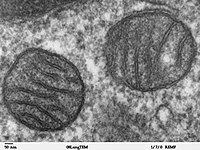
Photo from wikipedia
BACKGROUND Obsessive-compulsive disorder (OCD) is a clinically heterogeneous condition. To better understand and treat patients, symptomatology of OCD has been categorized into more homogenous symptom dimensions. The autogenous-reactive classification model… Click to show full abstract
BACKGROUND Obsessive-compulsive disorder (OCD) is a clinically heterogeneous condition. To better understand and treat patients, symptomatology of OCD has been categorized into more homogenous symptom dimensions. The autogenous-reactive classification model has proven helpful in the elucidation of the neurobiological substrates for clinical heterogeneity in OCD. The purpose of the current study was to systematically compare regional and network functional alterations between OCD subtypes based on the autogenous-reactive model. METHODS Autogenous-type OCD patients (OCD-AO, n = 40), reactive-type patients (OCD-RO, n = 42), and healthy controls (HC, n = 70) underwent functional magnetic resonance imaging (fMRI) scans. The amplitude of low-frequency fluctuation (ALFF) and regional homogeneity (ReHo) were compared among subjects. Areas of abnormal local spontaneous brain activity that differentiated OCD-AO and OCD-RO patients were identified and entered as seeds in functional connectivity (FC) analysis. RESULTS Compared to OCD-RO patients and HC participants, OCD-AO patients showed increased ALFF in the left anterior insula (AI), increased ReHo in the right AI, and hyperconnectivity between bilateral AI and anterior cingulate cortex (ACC). Both OCD-AO and OCD-RO patients shared regional function deficits in several areas within the prefrontal cortex, and stronger FC between bilateral AI and major nodes of the default mode network (DMN) compared to healthy controls. CONCLUSION The current results suggest that aberrant functional interaction between the salience network (SN) and the DMN may represent a common substrate in the pathophysiology of OCD, while impaired functional coupling within the SN is distinct to autogenous-type OCD patients. These findings provide further neurobiological evidence to support the autogenous-reactive classification model and contribute to the understanding of the neurobiological basis for clinical heterogeneity in OCD.
Journal Title: Progress in Neuro-Psychopharmacology and Biological Psychiatry
Year Published: 2020
Link to full text (if available)
Share on Social Media: Sign Up to like & get
recommendations!